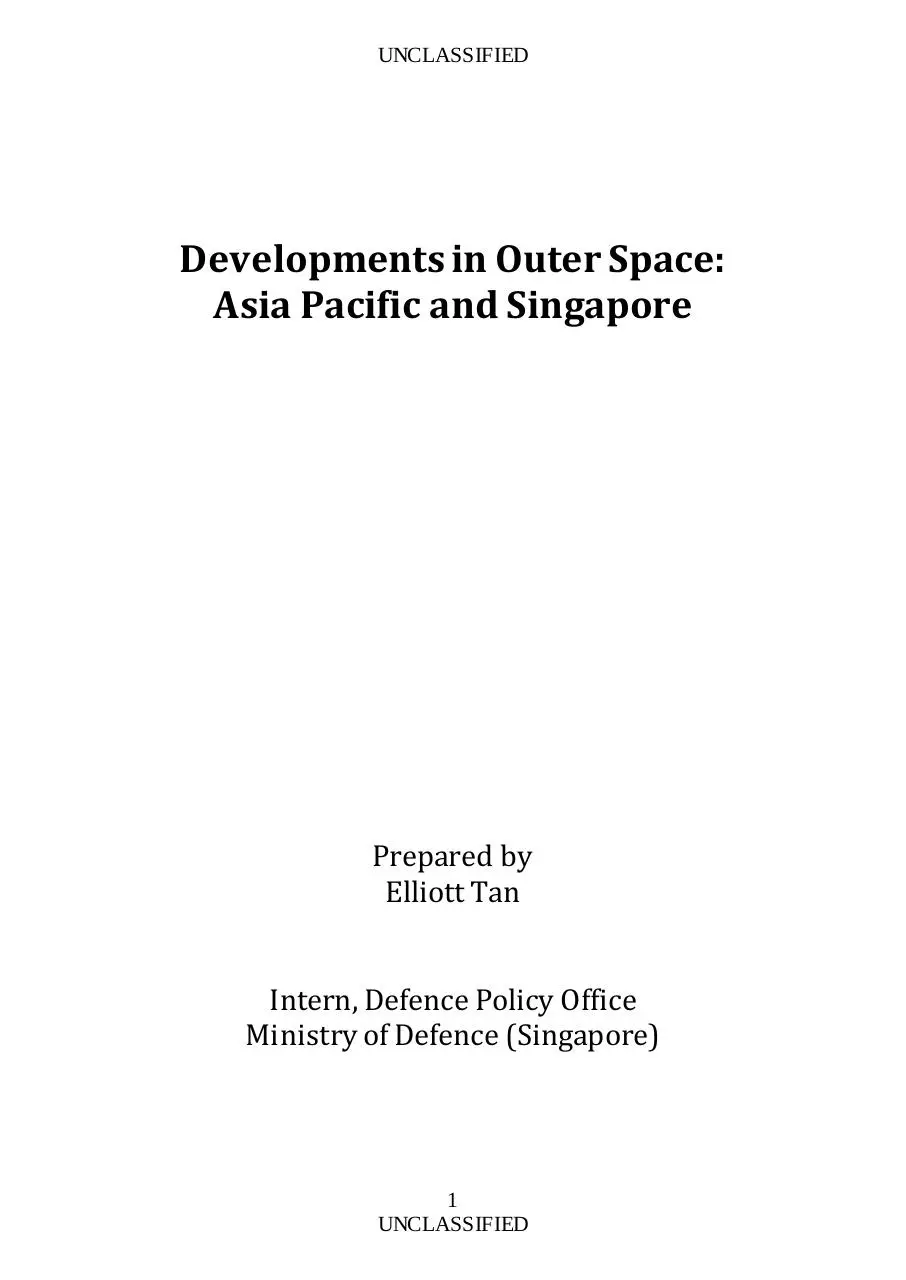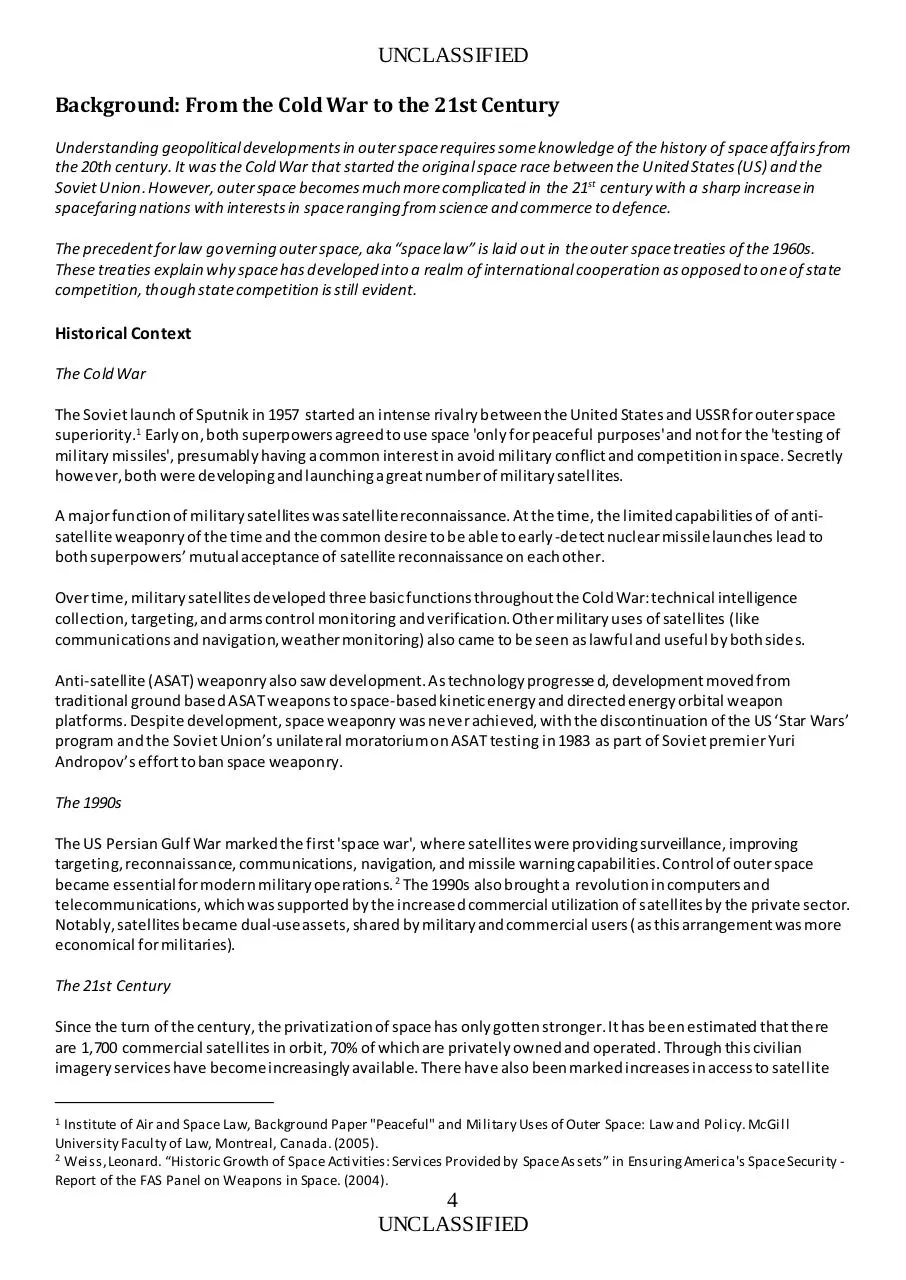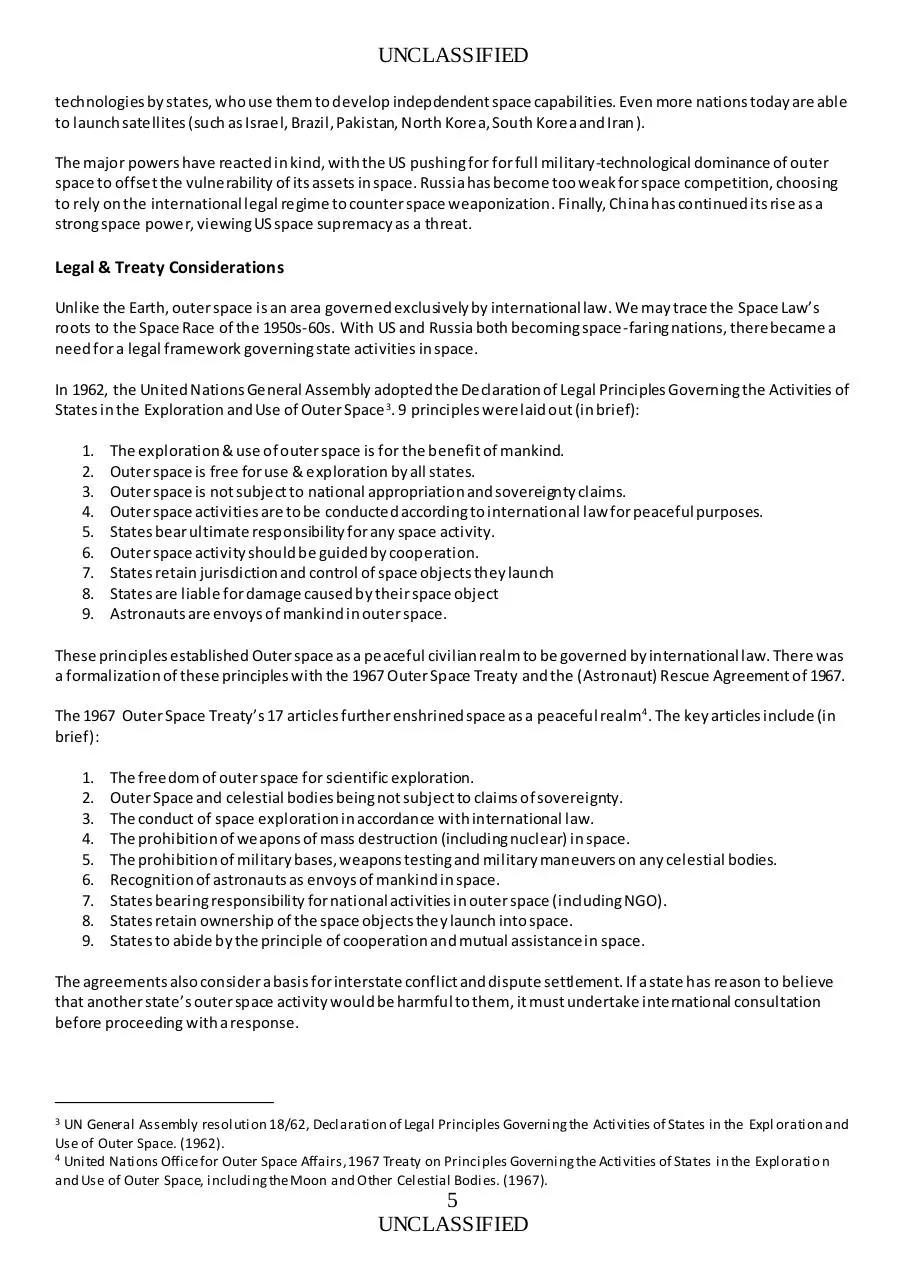Developments in Outer Space (PDF)
File information
This PDF 1.5 document has been generated by , and has been sent on pdf-archive.com on 12/12/2016 at 22:27, from IP address 84.110.x.x.
The current document download page has been viewed 2588 times.
File size: 1.17 MB (36 pages).
Privacy: public file





File preview
UNCLASSIFIED
Developments in Outer Space:
Asia Pacific and Singapore
Prepared by
Elliott Tan
Intern, Defence Policy Office
Ministry of Defence (Singapore)
1
UNCLASSIFIED
UNCLASSIFIED
Table of Contents
Executive Summary.............................................................................................................................................. 3
Background: From the Cold War to the 21st Century .............................................................................................. 4
Historical Context.............................................................................................................................................. 4
Legal and Treaty Considerations......................................................................................................................... 5
Weapons of Outer Space ...................................................................................................................................... 8
Existing Space-Related Weaponry ...................................................................................................................... 8
Diagrams of Space Weaponry ............................................................................................................................ 9
Future Space Capabilities..................................................................................................................................11
Key Space Developments in Asia-Pacific...............................................................................................................13
Major Power Considerations.............................................................................................................................13
ASEAN Regional Considerations ........................................................................................................................15
The National Interest ..........................................................................................................................................20
Singapore’s Existing Space Assets ......................................................................................................................20
Navigating the Geopolitics of Outer Space .........................................................................................................23
Enhancing Singapore’s Space Capabilities ..........................................................................................................24
References..........................................................................................................................................................25
Appendix ............................................................................................................................................................30
Asia Pacific Space Agencies ...............................................................................................................................30
Asia Pacific Spacefaring Capabilities ..................................................................................................................32
Asia Pacific Space Agreements ..........................................................................................................................33
Spaceports with Achieved Manned Spaceflight ..................................................................................................35
Spaceports with Achieved Satellite Launches .....................................................................................................35
2
UNCLASSIFIED
UNCLASSIFIED
Executive Summary
The history of outer space has been defined by three major periods. The Cold War’s superpower rivalry between the
United States and the Soviet Union set new precedents for space exploration and shaped today’s international norms.
The 1990s saw the privitization and commercialization of space as well as the first major use of space assets in
combat. Finally, the 21st century has been marked by a proliferation of spacefaring nations, complicating the realm of
space with many different national interests of both peaceful and military purposes.
4 major space treaties define the rules of international space activity. The 1967 Outer Space treaty, the 1967
Astronaut Rescue Agreement the 1972 Liability Convention and the 1974 Registration Convention. They have
established outer space as a realm of peaceful international cooperation, though this realm is not free from state
competition.
Existing outer space weapons typically target satellites and may consist of interceptor satellites, ground based antisatellite weapons of kinetic or directed energy, fighter-jet launched interceptors and satellite jammers. There is also
the threat of high altitude nuclear explosion. All present threats to satellites in low-earth, mid-earth and
geosynchronous orbit. Trends for the future of space weapon development point to major power competition over
sub-orbital hypersonic missiles and infantry space transportation.
The major powers of the United States, China and Russia all have vested interest in controlling outer space. The US’
heightened vulnerability from its heavy dependence on satellite systems has made it anxious to project space
superiority. China’s status as a rising space power makes it want to seek parity with the US in terms of space
capability and is developing anti-satellite weapons as an asymmetric counter to US space dominance. Russia as a
weakened space power has relied more on the international legal regime to project its will.
In Southeast Asia, Indonesia and Malaysia appear in the lead in terms of space development. Both have dedicated
space agencies, with the former researching rocket technology and the latter having achieved manned spaceflight.
Thailand, Singapore and Vietnam follow behind, more focused on developing remote sensing capabilities and the
ability to take high resolution imagery. The Phillipines interest in space is more scientific, while Laos has become
totally dependent on China to fund its satellite program. Cambodia, East Timor and Myanmar do not appear to be
conducting space development.
It is in the national interest to ensure that Singapore remains relevant in a world increasingly engaged in outer space.
It must catch up with the region in space development and should engage in bilateral and multilateral cooperation to
develop its independent space capabilities. Leveraging economic comparative advantages, Singapore should be able
to carve out a niche in the outer space community.
3
UNCLASSIFIED
UNCLASSIFIED
Background: From the Cold War to the 21st Century
Understanding geopolitical developments in outer space requires some knowledge of the history of space affairs from
the 20th century. It was the Cold War that started the original space race between the United States (US) and the
Soviet Union. However, outer space becomes much more complicated in the 21st century with a sharp increase in
spacefaring nations with interests in space ranging from science and commerce to defence.
The precedent for law governing outer space, aka “space law” is laid out in the outer space treaties of the 1960s.
These treaties explain why space has developed into a realm of international cooperation as opposed to one of state
competition, though state competition is still evident.
Historical Context
The Cold War
The Soviet launch of Sputnik in 1957 started an intense rivalry between the United States and USSR for outer space
superiority.1 Early on, both superpowers agreed to use space 'only for peaceful purposes' and not for the 'testing of
military missiles', presumably having a common interest in avoid military conflict and competition in space. Secretly
however, both were developing and launching a great number of military satellites.
A major function of military satellites was satellite reconnaissance. At the time, the limited capabilities of of antisatellite weaponry of the time and the common desire to be able to early-detect nuclear missile launches lead to
both superpowers’ mutual acceptance of satellite reconnaissance on each other.
Over time, military satellites developed three basic functions throughout the Cold War: technical intelligence
collection, targeting, and arms control monitoring and verification. Other military uses of satellites (like
communications and navigation, weather monitoring) also came to be seen as lawful and useful by both sides.
Anti-satellite (ASAT) weaponry also saw development. As technology progresse d, development moved from
traditional ground based ASAT weapons to space-based kinetic energy and directed energy orbital weapon
platforms. Despite development, space weaponry was never achieved, with the discontinuation of the US ‘Star Wars’
program and the Soviet Union’s unilateral moratorium on ASAT testing in 1983 as part of Soviet premier Yuri
Andropov’s effort to ban space weaponry.
The 1990s
The US Persian Gulf War marked the first 'space war', where satellites were providing surveillance, improving
targeting, reconnaissance, communications, navigation, and missile warning capabilities. Control of outer space
became essential for modern military operations. 2 The 1990s also brought a revolution in computers and
telecommunications, which was supported by the increased commercial utilization of satellites by the private sector.
Notably, satellites became dual-use assets, shared by military and commercial users (as this arrangement was more
economical for militaries).
The 21st Century
Since the turn of the century, the privatization of space has only gotten stronger. It has been estimated that there
are 1,700 commercial satellites in orbit, 70% of which are privately owned and operated. Through this civilian
imagery services have become increasingly available. There have also been marked increases in access to satellite
1
Institute of Air and Space Law, Background Paper "Peaceful" and Military Uses of Outer Space: Law and Policy. McGill
University Faculty of Law, Montreal, Canada. (2005).
2 Weiss, Leonard. “Historic Growth of Space Activities: Services Provided by Space As sets” in Ensuring America's Space Security Report of the FAS Panel on Weapons in Space. (2004).
4
UNCLASSIFIED
UNCLASSIFIED
technologies by states, who use them to develop indepdendent space capabilities. Even more nations today are able
to launch satellites (such as Israel, Brazil, Pakistan, North Korea, South Korea and Iran).
The major powers have reacted in kind, with the US pushing for for full military-technological dominance of outer
space to offset the vulnerability of its assets in space. Russia has become too weak for space competition, choosing
to rely on the international legal regime to counter space weaponization. Finally, China has continued its rise as a
strong space power, viewing US space supremacy as a threat.
Legal & Treaty Considerations
Unlike the Earth, outer space is an area governed exclusively by international law. We may trace the Space Law’s
roots to the Space Race of the 1950s-60s. With US and Russia both becoming space-faring nations, there became a
need for a legal framework governing state activities in space.
In 1962, the United Nations General Assembly adopted the Declaration of Legal Principles Governing the Activities of
States in the Exploration and Use of Outer Space 3. 9 principles were laid out (in brief):
1.
2.
3.
4.
5.
6.
7.
8.
9.
The exploration & use of outer space is for the benefit of mankind.
Outer space is free for use & exploration by all states.
Outer space is not subject to national appropriation and sovereignty claims.
Outer space activities are to be conducted according to international law for peaceful purposes.
States bear ultimate responsibility for any space activity.
Outer space activity should be guided by cooperation.
States retain jurisdiction and control of space objects they launch
States are liable for damage caused by their space object
Astronauts are envoys of mankind in outer space.
These principles established Outer space as a peaceful civilian realm to be governed by international law. There was
a formalization of these principles with the 1967 Outer Space Treaty and the (Astronaut) Rescue Agreement of 1967.
The 1967 Outer Space Treaty’s 17 articles further enshrined space as a peaceful realm 4 . The key articles include (in
brief):
1.
2.
3.
4.
5.
6.
7.
8.
9.
The freedom of outer space for scientific exploration.
Outer Space and celestial bodies being not subject to claims of sovereignty.
The conduct of space exploration in accordance with international law.
The prohibition of weapons of mass destruction (including nuclear) in space.
The prohibition of military bases, weapons testing and military maneuvers on any celestial bodies.
Recognition of astronauts as envoys of mankind in space.
States bearing responsibility for national activities in outer space (including NGO).
States retain ownership of the space objects they launch into space.
States to abide by the principle of cooperation and mutual assistance in space.
The agreements also consider a basis for interstate conflict and dispute settlement. If a state has reason to believe
that another state’s outer space activity would be harmful to them, it must undertake international consultation
before proceeding with a response.
3
UN General Assembly resolution 18/62, Declaration of Legal Principles Governing the Activities of States in the Expl oration and
Use of Outer Space. (1962).
4 United Nations Office for Outer Space Affairs, 1967 Treaty on Principles Governing the Activities of States in the Exploratio n
and Use of Outer Space, including the Moon and Other Celestial Bodies. (1967).
5
UNCLASSIFIED
UNCLASSIFIED
Giving weight to the Outer Space Treaty, the United States, United Kingdom and Soviet Union were the first few to
accede to and ratify, establishing an understanding between Cold War powers about their conduct in space. The
subsequent 1967 Rescue Agreement also created a legal basis for states to return astronauts to their country of
origin and to make all effort to rescue stranded astronauts.
The Partial Nuclear Test Ban of 1963 further reinforced the prevention of WMD proliferation in space. Primarily
between the United States, United Kingdom and Soviet Union in the wake of increasingly more destructive nuclear
tests and preceding tests already conducted in space and underwater, the treaty banned the testing of nuclear
weapons in space 5. With these developments, while nuclear weapons were banned from space, there was no actual
prohibition of orbital conventional weapons in space.
Further treaties governing the use of space appeared in the 1970s, with the 1972 Convention on Internationa l
Liability for Damage Caused by Space Objects (aka the Liability Convention) and the 1974 Convention of Registration
of Objects Launched into Outer Space (aka the Registration Convention). The Liability Convention settled issues
regarding liability, charging states with the liability for damage caused from launching its objects.
The Registration Convention ensured that objects in space were properly registered, with all launches recorded in a
central register maintained by the UN and necessary information provided, also making it hard for states to launch
conventional weapons into space secretly.
So far, international legal cooperation for peaceful space exploration had gone with no major disputes. But this
progress was checked when the 1979 Agreement of States on the Moon & Celestial Bodies (aka the Moon Treaty) 6
was not signed and ratified by many countries. It contents included (briefly):
1. All activities carried out on the moon (or celestial bodies) to be in accordance with international law
2. the moon to be used exclusively for peaceful purposes (prohibition of orbital WMDs, military bases,
weapons tests and military maneuvers)
3. The need for states to update the UN on its activities on the moon
4. The freedom of scientific investigation of the moon
5. The environmental protection of the moon
6. The freedom to land and launch, place objects and traverse the moon
7. The freedom to establish a moon base after informing the UN secretary general
8. The recognition of the moon and its natural resources as the heritage of mankind not subject to claims of
sovereignty or discrimination.
9. The establishment of an international regime governing moon natural resource exploitation
Objections over treaty provisions on the moon’s natural resources lead to its rejection by all spacefaring nations who
have not ratified the agreement. Since then, there have been few major legal additions to space law.
Since then the UN General Assembly has passed a few more resolutions on space; namely the Principles Relevant to
the Use of Nuclear Power Sources in Outer Space in 1992 and the Declaration of International Cooperat ion in the
Exploration and Use of Outer Space (…) in 1996. The former gives permission for the use of nuclear reactors to
further space exploration, the latter reinforces the principles enshrined in the Outer Space Treaty and Legal Principle
Declaration.
The conduct of states in space is laid out in the various treaties and UN principles listed earlier, but space’s
commercial use has also not been neglected. The International Mobile Satellite Organization (IMSO) coordinates
long range identification and tracking for maritime, aeronautical and land purposes by satellite, acting exclusively for
5
United Nations Office for Disarmanent Affairs, Treaty Banning Nuclear Weapon Tests in the Atmosphere, in Outer Space and
Under Water. (1963).
6 United Nations Office for Outer Space Affairs, 1979 Agreement Governing the Activities of States on the Moon and Other
Celestial Bodies. (1979).
6
UNCLASSIFIED
UNCLASSIFIED
peaceful purposes 7. The International Telecommunications Satellite Organization (ITSO) ensures private
telecommunication companies adhere to maintaining global coverage and connectivity and provide nondiscriminatory access to the satellite system8. Finally the International Telecommunication Constitution and
Convention (ITU) maintains and extends cooperation amongst member states for telecommunications, allocating
radio frequencies for space services and standardizing telecommunications 9 . Simply, there is an existing civilian
infrastructure for the coordination of telecommunication satellites.
- end of section -
7
International Mobile Satellite Organization, Text of the Convention on the International Mobile Satellite Organization. (2007).
International Telecommunications Satellite Organization, Agreement Relating To the International Telecommunications Union.
(1971).
9 International Telecommunication Union, Collection of the Basic Texts of the International Telecommunication Union Adopted
by the Plenipotentiary Conference. (2011).
8
7
UNCLASSIFIED
UNCLASSIFIED
Weapons of Outer Space
Satellites are of strategic military importance to modern military warfighting. As such, states have been developing
weaponry to strike key targets in outer space, crippling their adversaries. In addition, although orbital weapons
platforms have never been deployed, their development is within the reach of spacefaring nations. By understanding
the actual vulnerabilities and capabilities of space faring nations may we understand the geopolitics of outer space.
Existing Space-Related Weaponry
States have already developed some forms of weaponry to target objects in space. It may be safely assumed that
states have ability to develop the following space or ASAT weapons:
Small Satellites
A recent trend is the miniaturization of satellites. For visualization, a small satellite is one that is
under 500kg. Smaller satellites are cheaper, easier to build and launch. 10 These advances
essentially allow for the proliferation of satellite capabilities amongst a wider array of nations, ie:
more interests, motivations and rivalries in Outer Space.
Ground Based
Anti-Satellite
Weapons
(Kinetic)
Satellite weaponisation can be accomplished through a variety of means. The smaller size allows
it an element of stealth in approaching other satellites. It may also function as a 'space mine',
disabling specific satellites it chooses to intercept through explosives or other means. For
example, the Chinese have reportedly developed a parasitic satellite able intercept and to disable
a target satellite.
Kinetic ASAT weapons would seek to launch themselves into orbit and destroy space assets
through direct collision. This usually requires the launch state to have the necessary launch
capability, and to have a precise enough tracking capability. For example, the North Korean Scud C missile can reach 300km while the Nodong missile can reach 500km, all within low-earth orbit.
Ground Based
Anti-Satellite
Weapons (Direct
Energy)
More technologically advanced states have been making investments into direct energy aka laser
weapons. Direct energy ASAT weapons attack space assets through heat damage. They can
explode external pressurized fuel tanks and destroy satellite optics (disabling reconnaissance).
They may also disrupt through overheating a satellite's solar cells, disabling it.
The destructiveness of laser weapons are measured in megawatts per square meter. Given
enough power, laser weapons could ostensibly reach targets in geosynchronous earth orbit
(GEO). As an example of direct energy weapons application at sea, the US Navy has already field
tested the AN/SEQ-3 laser on the USS Ponce. It has been shown to disable boat engines and
shoot down drones in flight.
Low Earth Orbit
(LEO) Launched
Interceptors
In order to kinetically attack GEO satellites, interceptors would need to be launched from LEO,
perhaps out of a fighter jet. In theory, it is feasible because the interception velocity is
manageable, homing can be done through optical systems. The interceptor would still require
enough energy to enter orbit.
High Altitude
Nuclear
Explosion
(HANE)
The detonation of nuclear bomb in high altitude has 2 effects: Firstly, there would be an
electromagnetic pulse affecting all electrical systems within line-of-sight of the explosion.
Secondly, there would be the 'Christofilos' effect. A HANE would create arti ficial radiation belts,
supercharging the natural Van Allen belts, causing LEO satellites to degrade much faster due to
bombardment by excess radiation. 11
10
Weiss, Leonard. “United States Space Systems Vulnerabilities and Threats - Introduction” in Ensuring America's Space Security
- Report of the FAS Panel on Weapons in Space. (2004).
11 Papadopoulos, Dennis. “Satellite Threat Due to High-Altitude Nuclear Detonation” in Ensuring America's Space Security Report of the FAS Panel on Weapons in Space. (2004).
8
UNCLASSIFIED
UNCLASSIFIED
The US Starfish high-altitude nuclear test of 1962 is the most well known example of a HANE.
EMP effects were seen in Hawaii while man-made radiation belts eventually cripped one third of
all satellites in LEO. Further HANE tets have been curbed by the nuclear test-ban treaty.
GEO satellite
jamming
It has also been suggested that a method to attack GEO satellites is to overwhelm it with
incoming signals, so that data it returns to the ground station is incomprehensible.
For example, the 2003 jamming of the Telestar-12 by Cuba to foil the broadcasting of US Persianlanguage propaganda into Iran is an example.
Orbital debris
The use of kinetic weapons is curtailed by the effects of creating more orbital debris. Kinetically
destroying a satellite would create orbital debris that could impact other satellites, creating a
chain reaction of orbital debris strikes. Therefore, kinetic strikes are less desirables for nations
with space assets.
Diagrams of Space Weaponry
The following diagrams help us to understand the capabilities of space weaponry (to scale).
Explanation of Earth Orbits
An orbit is determined by the distance of the
space object to earth.
Low Earth Orbit (LEO) is anywhere between
160km to 2000km away from earth.
Medium Earth Orbit (MEO) is between 2000 to
35,786km from earth.
Geostationary (or Geosynchronous) Earth Orbit
(GEO) is a distance of more than 35,786km
away from earth.
Diagram of LEO Interceptors
LEO interceptors are missiles launched from a
F-16 in earth’s atmosphere. Upon release, they
use their own propellant to break free of
earth’s gravity to reach LEO, MEO or GEO
depending on how much propellant is used.
Air-launched satellites use a similar technique
to achieve orbit.
9
UNCLASSIFIED
Download Developments in Outer Space
Developments in Outer Space.pdf (PDF, 1.17 MB)
Download PDF
Share this file on social networks
Link to this page
Permanent link
Use the permanent link to the download page to share your document on Facebook, Twitter, LinkedIn, or directly with a contact by e-Mail, Messenger, Whatsapp, Line..
Short link
Use the short link to share your document on Twitter or by text message (SMS)
HTML Code
Copy the following HTML code to share your document on a Website or Blog
QR Code to this page

This file has been shared publicly by a user of PDF Archive.
Document ID: 0000521329.